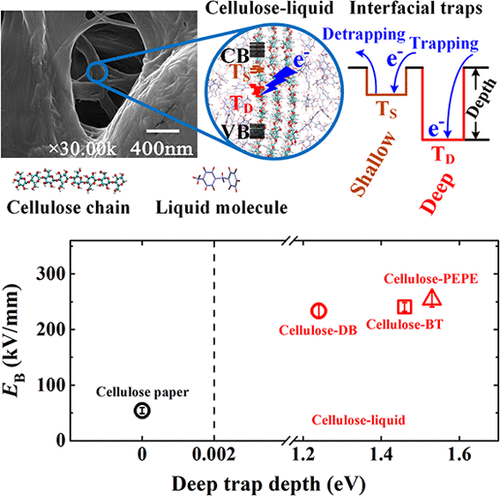当前位置:
X-MOL 学术
›
J. Phys. Chem. Lett.
›
论文详情
Our official English website, www.x-mol.net, welcomes your
feedback! (Note: you will need to create a separate account there.)
Substantial Improvement of the Dielectric Strength of Cellulose-Liquid Composites: Effects of Traps at the Nanoscale Interface.
The Journal of Physical Chemistry Letters ( IF 4.8 ) Pub Date : 2020-02-24 , DOI: 10.1021/acs.jpclett.0c00235 Guanghao Qu 1 , Huize Cui 1 , Yuanwei Zhu 1 , Liuqing Yang 1 , Shengtao Li 1
The Journal of Physical Chemistry Letters ( IF 4.8 ) Pub Date : 2020-02-24 , DOI: 10.1021/acs.jpclett.0c00235 Guanghao Qu 1 , Huize Cui 1 , Yuanwei Zhu 1 , Liuqing Yang 1 , Shengtao Li 1
Affiliation

|
The dielectric strength of cellulose-liquid composites is always about several times higher than that of the cellulose paper and insulating liquids. However, this experimental phenomenon has not yet been demonstrated theoretically. Herein, the spectra characterization, molecular simulation, and wave function analysis method provide a new insight that the role of nanoscale interfacial adsorption of cellulose-liquid is exclusive for composites affecting the charge separation and producing the deep-level traps to seriously hinder electromigration under an electric field, which is responsible for the difference in dielectric strength. Meanwhile, the π conjugation and σ-π hyperconjugation effects enhance the electrical stability of aromatic hydrocarbon insulating liquids. In conclusion, interfacial trap theory can be used to explain the correlation of dielectric strength between cellulose-liquid composites and cellulose paper or dielectric liquids. It can be expected that materials with high dielectric strength can be manufactured according to the fundamental study of interfacial trap theory.
中文翻译:

纤维素-液体复合材料介电强度的显着提高:纳米级界面处陷阱的影响。
纤维素-液体复合材料的介电强度始终比纤维素纸和绝缘液体的介电强度高约几倍。但是,这种实验现象尚未在理论上得到证明。本文中,光谱表征,分子模拟和波函数分析方法提供了新的见解,即纤维素-液体的纳米级界面吸附作用仅对复合物产生影响,这些复合物会影响电荷分离并产生深能级陷阱,从而严重阻碍电迁移。电场,这是介电强度差异的原因。同时,π共轭和σ-π超共轭效应增强了芳烃绝缘液体的电稳定性。结论,界面陷阱理论可用于解释纤维素-液体复合材料与纤维素纸或介电液体之间的介电强度的相关性。可以预期,可以根据界面陷阱理论的基础研究来制造具有高介电强度的材料。
更新日期:2020-02-24
中文翻译:

纤维素-液体复合材料介电强度的显着提高:纳米级界面处陷阱的影响。
纤维素-液体复合材料的介电强度始终比纤维素纸和绝缘液体的介电强度高约几倍。但是,这种实验现象尚未在理论上得到证明。本文中,光谱表征,分子模拟和波函数分析方法提供了新的见解,即纤维素-液体的纳米级界面吸附作用仅对复合物产生影响,这些复合物会影响电荷分离并产生深能级陷阱,从而严重阻碍电迁移。电场,这是介电强度差异的原因。同时,π共轭和σ-π超共轭效应增强了芳烃绝缘液体的电稳定性。结论,界面陷阱理论可用于解释纤维素-液体复合材料与纤维素纸或介电液体之间的介电强度的相关性。可以预期,可以根据界面陷阱理论的基础研究来制造具有高介电强度的材料。




















































 京公网安备 11010802027423号
京公网安备 11010802027423号